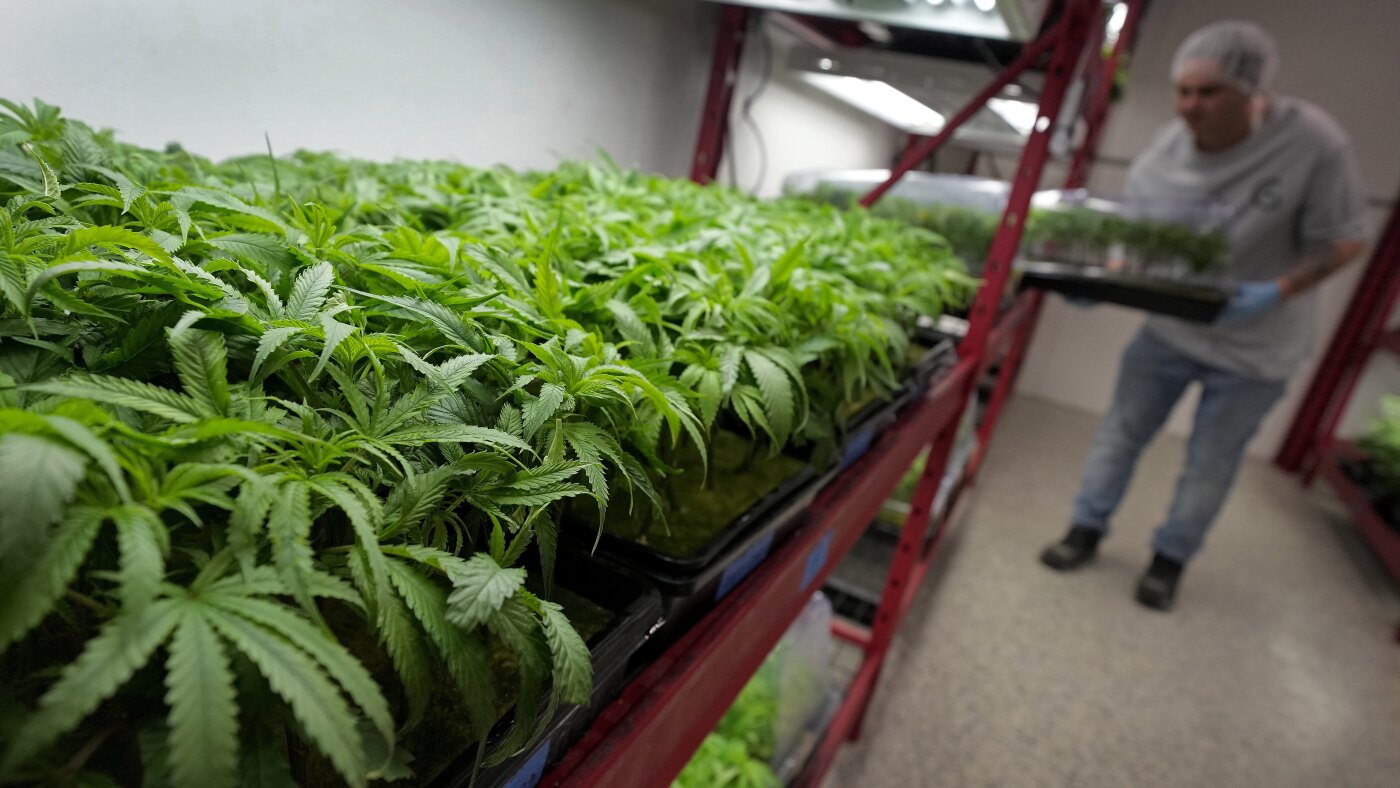Iowa
Iowa Pork Producers look to replace ISU player in viral ‘Purchase Moore Hamann Bacon’ ad

Former walk-on Caleb Bacon on playing for the Iowa State football team
Former walk-on Caleb Bacon talks about playing for the Iowa State football team
Iowans love pork and and they love football.
That is why the Iowa Pork Producers Association is bringing back the viral promotion involving Iowa State University athletes who throw around the old pig skin.
In hopes of encouraging people to buy more ham and bacon, the Iowa Pork Producers Association used a name, image and likeness deal with the last names of Iowa State football players.
Conveniently enough, the last names of ISU Cyclone football players Myles Purchase, Tyler Moore, Tommy Hamann and Caleb Bacon make for a convincing ad campaign: “Purchase Moore Hamann Bacon.” Since the first promotion, Cyclones Alec Cook and Zach Lovett joined the team.
When the promotion first dropped last year, it went viral with millions of views and a feature on ESPN SportsCenter’s social media account, according to the Iowa Pork Producers Association. The Sports Business Journal also named the partnership the Best NIL Deal of 2023.
The promotional campaign is coming back for 2024 and the association is looking for more Cyclones to join.
More: Hardly anyone recruited Caleb Bacon in high school. Now he’s a football star at Iowa State
What’s new for the ‘Purchase Moore Hamann Bacon’ campaign?
Hamann will no longer take part in the promotion. He recently decided to leave Iowa State’s football program to focus on his engineering degree, according to the IPPA. A video came out of Hamann saying goodbye to his fellow teammates.
But this isn’t the end of the campaign. The IPPA is looking for more students to join the promotional cast.
Where can I watch the 2024 ‘Purchase Moore Hamann Bacon’ promotional videos?
Videos can be found on the Iowa Pork Producers Association’s YouTube or social media. Every Monday at 10 a.m. for the next seven weeks, new tryout videos of Cyclone students will air to see if they fit into the “Purchase Moore Hamann Bacon” mantra. The series will end Oct. 7, just in time for National Pork Month known as Porktober.
Pork promotion donates to food banks
For every student who takes part in the ad campaign, IPPA will donate $1,000 worth of pork to a food pantry of the student’s choice. Last year, $13,000 worth of pork was given to food pantries. Donations from the most recent video will go toward the following food banks:
- Food Bank of the Rockies in Denver, Colorado, in the name of Myles Purchase
- DMARC in Des Moines, Iowa, in the name of Tyler Moore
- Interfaith Outreach & Community Partners in Plymouth, Minnesota, in the name of Tommy Hamann
- Lake Mills Food Shelf in Lake Mills, Iowa, in the name of Caleb Bacon
- Food Bank for the Heartland in Omaha, Nebraska, in the name of Alec Cook
- Second Harvest Food Bank of Central Florida, in the name of Zach Lovett
Kate Kealey is a general assignment reporter for the Des Moines Register. Reach her at kkealey@registermedia.com or follow her on Twitter at @Kkealey17.

Iowa
Iowa High School Girls Basketball: Top Junior Players

With the season coming out of the holiday break, now is the perfect time to take a look at the top Iowa high school girls basketball players by grade.
These are just some of the top players in Iowa and not a complete list of all of them. Statistics are based on those uploaded to the Bound website by January 4, 2026.
Here are the top junior girls basketball players in Iowa high school basketball:
A high-level producer, Maggie McChesney heads into 2026 averaging 23.6 points, nine rebounds, 2.7 steals, 2.6 assists and over two blocks per game.
The next standout from North Union, Ainsley Ulrich is posting nearly 23 points with six rebounds, and over three steals a night.
Flirting with averaging a double-double is Izzy Gilbertson, as the junior stands at 21.7 points, 9.7 rebounds, four blocks, 3.6 steals and three assists.
Along with posting 20 points and grabbing six rebounds, Cora Sauer also adds four steals and three assists.
A big sophomore season has carried right over for Melina Snoozy, as she leads the Crusaders with 20 points, eight rebounds and 3.5 steals a night, along with averaging a block per game.
Up north is Riley Meyer, a 20-point scorer per game who adds six rebounds and two steals.
Sitting right under 20 points a night is Addy Wolfswinkel, as she is also averaging five rebounds, three assists and three steals.
A standout on both ends, Maryn Franken posts nearly 20 points and over eight rebounds per game with three steals and 1.4 blocks.
Following in the footsteps of Audi Crooks, Graclyn Eastman has been nearly unstoppable for the Golden Bears, scoring 19 points per game with nine rebounds, 3.5 steals, 2.6 blocks and two assists.
Another Maroon standout named Muller, Katie is scoring over 18 points per game with six rebounds, 3.5 assists and over a block and steal.
One of the top players in the North Central Conference, Hayden McLaughlin has taken over as the No. 1 option for the Bulldogs, scoring 17 points per game with nearly six rebounds and two steals.
The Hawks rely on KeaOnna Worley to do a lot, and she delivers nightly, scoring 16.5 points with nearly five assists, four rebounds and two steals.
The balanced Comets are led by Campbell Schulz, as the junior posts 14 points, 4.6 rebounds, four assists, three steals and nearly three blocks.
Forming a powerful 1-2 punch with Addy Wolfswinkel is Deidra Doeden, who averages 18 points and 13.5 rebounds per game.
Down low for North Mahaska is Natallya Linder, a nightly double-double at 15.7 points and 13 rebounds to go along with 2.6 steals, 2.3 assists and a block.
The last name has long been a staple for Pella Christian, and Rachel is carrying it on now, averaging 14 points, 11 rebounds, four assists, two steals and a block per game.
The forward is a threat all over the court for the Falcons, posting 18 points, 11.6 rebounds, two steals, two assists and a block.
Triple-doubles are in the future for Aniya Hardee, as she is averaging nine points, 8.2 rebounds, 7.6 assists and nearly five steals per game.
Iowa
Penn State earns commitment from Iowa State leading wide receiver via transfer
Penn State landed Iowa State’s pair of quarterbacks earlier Sunday, including starter Rocco Becht, in a splash move. Now, the Cyclones’ leading receiver is coming with them.
Wide receiver Brett Eskildsen committed to Penn State via the transfer portal, becoming the seventh Cyclone to join the Nittany Lions this weekend. He announced the move on social media.
Eskildsen recorded 30 receptions, 526 yards and five touchdowns as a sophomore in 2025. He also appeared in all 13 games as a freshman but made just two catches for 17 yards.
The 6-1, 200-pound wideout is from Frisco, Texas, and is a three-star in the 247Sports transfer rankings (No. 118 overall, No. 30 WR). He was a three-star out of high school as well, where he had more than 1,5000 career receiving yards.
Becht’s top man from 2026 is now in place. He’ll also be able to throw to standout Penn State freshman Koby Howard and quick youngster Tyseer Denmark, who have confirmed their returns thus far.
Listen to the Blue-White Breakdown podcast
Iowa
Iowa State picks up commitment from Arkansas State QB Jaylen Raynor

Iowa State football has picked up a commitment from Arkansas State quarterback Jaylen Raynor, ESPN’s Pete Thamel reported on Jan. 3.
Raynor has one season of eligibility remaining. The 6-foot, 202-pounder from Kernersville, North Carolina, passed for 3,361 yards and 19 touchdowns this season. He was intercepted 11 times.
Raynor also rushed for 423 yards and seven touchdowns.
He passed for 8,694 yards and 52 touchdowns in three seasons at Arkansas State.
“The (Iowa State) coaching staff is known for winning,” Raynor told Thamel. “The head coach is a known winner and done it on multiple levels.”
Raynor will join Arkansas State offensive coordinator Keith Heckendorf in Ames. Heckendorf was named Cyclones quarterbacks coach this week.
Raynor completed 19 of 33 passes for 222 yards in a 24-16 loss to Iowa State on Sept. 13, 2025.
-

 World1 week ago
World1 week agoHamas builds new terror regime in Gaza, recruiting teens amid problematic election
-

 Business1 week ago
Business1 week agoGoogle is at last letting users swap out embarrassing Gmail addresses without losing their data
-

 Indianapolis, IN1 week ago
Indianapolis, IN1 week agoIndianapolis Colts playoffs: Updated elimination scenario, AFC standings, playoff picture for Week 17
-

 Southeast1 week ago
Southeast1 week agoTwo attorneys vanish during Florida fishing trip as ‘heartbroken’ wife pleads for help finding them
-

 News1 week ago
News1 week agoRoads could remain slick, icy Saturday morning in Philadelphia area, tracking another storm on the way
-

 Politics1 week ago
Politics1 week agoMost shocking examples of Chinese espionage uncovered by the US this year: ‘Just the tip of the iceberg’
-

 News1 week ago
News1 week agoMarijuana rescheduling would bring some immediate changes, but others will take time
-

 World1 week ago
World1 week agoPodcast: The 2025 EU-US relationship explained simply





















